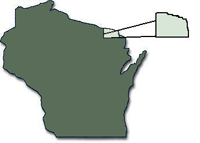 |
|
 |
 |
Many early ancestors followed the logging industry, which also followed the railroads...if you haven't located your families here in Florence County, do try the neighbouring counties in both Wisconsin and Michigan.
| FOREST WI | MARINETTE WI | DICKINSON MI | IRON MI | MENOMINEE MI |
Florence County was created in 1882 from territory that included parts of Marinette and Oconto Counties --(you
will need to know this when searching for census or land records). The county was named for Florence Hulst, the wife of N.P. Hulst, who
discovered a  number of iron mines in the area. The county seat is also named Florence. The county's natural resources consisted of vast quantities of hardwood and pine timber bordering the Menominee River, along with several large iron mines.
number of iron mines in the area. The county seat is also named Florence. The county's natural resources consisted of vast quantities of hardwood and pine timber bordering the Menominee River, along with several large iron mines.
Florence County is one of the few counties in Wisconsin in which the early pioneering era is still fairly recent. The area was undoubtedly visited by early French voyageurs and missionaries from the Green Bay region. The first European to leave any description of his journey along the Menominee and Brule Rivers was Captain Thomas Jefferson Cram, who surveyed the northwest boundary of Wisconsin in 840-41 (Carlson and others. 1971). Cram surveyed the Brule River, which forms part of the boundary with Michigan, and reported many Chippewa and Menominee Indians there. Florence County was a hunting and trapping region until iron ore was discovered in 1877. Three years earlier, iron had been discovered on the Michigan side of the border. Mining operations began during the winter of 1879-80, and peak production was reached in 1920. The population of the area that became Florence County increased from fewer than 300 in 1880 to 2,604 in 1890, only 8 years after the county was organized. The logging and lumbering in Florence County are associated with those industries in Marinette and Oconto Counties. The first sawmill in the territory was built in what is now Marinette County by William Farnsworth and Charles N. Bush in 1832. Although this date marked the beginning of lumbering in the territory, very little lumbering was done in the survey area prior to 1865. The primary timber in the early logging period was eastern white pine; a limited amount of red pine also was logged. By 1898, most of the eastern white pine had been cut. In the early 20th century, when the pine was gone, the logging of eastern hemlock and hardwoods was begun. Farming in Florence County had its origin in the need for agricultural products by the lumber companies. In 1890. there were 90 farms in the county. Farm numbers increased to 349 farms in 1920 and 580 farms in 1935. After this period, the number of farms in Florence County declined with the failing of small family farms and the growth of larger commercial farms. Please enjoy your visit and we're always looking for help -- look-up volunteers and if you have any information to contribute to the site, just let me know! |
DunnCoWI Coordinator: ColumbiaCoGA State Coordinator: Tina Vickery ColumbiaCoGA Assistant State Coordinator: Marcia Ann Kuehl
Complication Copyright 1996-Present - by The WIGenWeb Project Team
